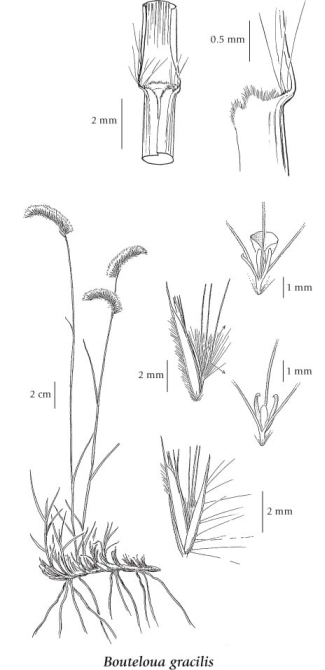blue grama
Poaceae (Grass family)
Introduction to Vascular Plants
Introduction
This native perennial, xenophytic, warm season, grass species is red-listed in British Columbia. It is a tufted, mat-forming species with short rhizomes. In North America, it is found across the central and western US (excluding Washington and Oregon), in a few northeastern states, and in five Canadian provinces (BC, Alberta, Manitoba, Saskatchewan and Ontario). In British Columbia, it has been collected in the southern interior, in the south-central and southeastern sections of the province, in dry grasslands the steppe zone (e.g. UBC Herbarium records: Brink, 1939, Kamloops; Bjork 2007, Thompson Plateau). It is reported as a "principle species of aspen parklands in Canada", but is also "found in the understorey of riparian cottonwood forests in the Central Plains" (Anderson 2003). Blue gamma grass produces abundant seed which is wind-dispersed (Anderson 2003). It has variable fire tolerance, although fire appears to favour this species (Anderson 2003). It is a facultative mycorrhizal species (Allen et al. 1984).
Blue gamma grass was reported from Europe (Barcelona, Spain) for the first time in 2004, from a dry, rocky area (Verloove 2004). References: Allen, Michael F., Edith B. Allen and Peter D. Stahl. 1984. Differential niche response of Bouteloua gracilis and Pascopyrum smithii to VA mycorrhizae. Bulletin of the Torrey Botanical Club 111 (3): 361-365. Anderson, Michelle D. 2003. Bouteloua gracilis. In: In: Fire Effects Information System, Available Online, U.S. Department of Agriculture, Forest Service, Rocky Mountain Research Station, Fire Sciences Laboratory (Producer). Verloove, Filip. 2004. Bouteloua gracilis (Chloridoideae, Poaceae), a new American xenophyte in Europe. Willdenowia 34: 67-69. Available Online. |
Species Information
General:
Perennial grass from short rhizomes, forming thick mats; stems slender, 20-40 (50) cm tall.
Leaves:
Leaves mostly basal and persistent; sheaths open, smooth to soft-hairy, the throats with numerous, stiff hairs mostly 1-1.5 (2) mm long, the collars usually smooth; blades 1-2 mm wide, flat, becoming crisp or curly in midwinter, smooth or commonly soft-hairy, the hairs from minutely blistery bases; ligules about 0.5 mm long.
Flowers:
Inflorescence of 2 (sometimes 1 or 3), straight or crescent-shaped, racemose spikes, 1.5-4 (5) cm long, short-stalked; spikelets usually 30-80, unstalked in 2 rows on one side of the rachis, with a single perfect flower below 1 or 2 greatly reduced sterile flowers, often purplish, the rudimentary florets consisting of lemmas only with awns 5-6 mm long; glumes about 2-3 and 3-5 (5.5) mm long, the lower much smaller and narrower, 1-nerved, fringed with hairs and more or less blistery on the keels; lowermost (fertile) lemmas about 6 mm long including the central awn-tipped lobes, 3-nerved; paleas about equalling the bodies of the lemmas, 2-nerved; rachillas not prolonged; anthers about 3 mm long; lodicules about 0.3 mm long.
Illustration

If more than one illustration is available for a species (e.g., separate illustrations were provided for two subspecies) then links to the separate images will be provided below. Note that individual subspecies or varietal illustrations are not always available.
Illustration Source: The Illustrated Flora of British Columbia
USDA Species Characteristics
Flower Colour:
Yellow
Blooming Period:
Early Summer
Fruit/Seed characteristics:
Colour: Brown
Present over the Summer
Source: The USDA
Ecology
The table below shows the species-specific information calculated from
original data (BEC database) provided by the BC Ministry of Forests and Range.
(Updated August, 2013)
| Site Information |
Value / Class |
||
|
Avg |
Min |
Max |
|
| Elevation
(metres) |
1094 | 968 | 1240 |
| Slope
Gradient (%) |
16 | 1 | 40 |
|
Aspect (degrees) |
177 | 148 | 251 |
| Soil
Moisture Regime (SMR) [0 - very xeric; 4 - mesic; 8 - hydric] |
3 | 2 | 4 |
| Modal
Nutrient Regime
Class |
D | ||
| #
of field plots species was recorded in: |
6 | ||
| Modal
BEC Zone Class |
IDF | ||
|
All BEC Zones (# of stations/zone) species was recorded in |
IDF(6) | ||
|
Source:
Klinkenberg 2013
|
|||
Habitat and Range
Dry grasslands in the steppe zone; rare in SC and SE BC; E to S MB and S to ME, NY, SC, MO, TX, NM, AZ and CA.Status Information
Synonyms
Synonyms and Alternate Names:
Bouteloua gracilis var. stricta (Vasey) A.S. Hitchc.
Bouteloua oligostachya (Nutt.) Torr. ex A. Gray
Chondrosum gracile Willd. ex Kunth
Chondrosum oligostachyum (Nutt.) Torr.